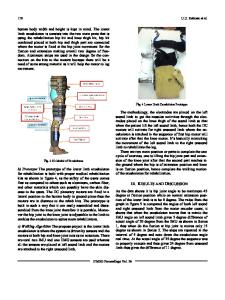Anisotropic design of a multilayered biological exoskeleton
- PDF / 2,491,477 Bytes
- 18 Pages / 584.957 x 782.986 pts Page_size
- 11 Downloads / 291 Views
Juha Song and Christine Ortiza) Department of Materials Science and Engineering, Massachusetts Institute of Technology, Cambridge, Massachusetts 02139
Mary C. Boyceb) Department of Mechanical Engineering, Massachusetts Institute of Technology, Cambridge, Massachusetts 02139 (Received 2 May 2009; accepted 29 September 2009)
Biological materials have developed hierarchical and heterogeneous material microstructures and nanostructures to provide protection against environmental threats that, in turn, provide bioinspired clues to improve human body armor. In this study, we present a multiscale experimental and computational approach to investigate the anisotropic design principles of a ganoid scale of an ancient fish, Polypterus senegalus, which possesses a unique quad-layered structure at the micrometer scale with nanostructured material constituting each layer. The anisotropy of the outermost prismatic ganoine layer was investigated using instrumented nanoindentations and finite element analysis (FEA) simulations. Nanomechanical modeling was carried out to reveal the elastic-plastic mechanical anisotropy of the ganoine composite due to its unique nanostructure. Simulation results for nanoindentation representing ganoine alternatively with isotropic, anisotropic, and discrete material properties are compared to understand the apparent direction-independence of the anisotropic ganoine during indentation. By incorporating the estimated anisotropic mechanical properties of ganoine, microindentation on a quad-layered FEA model that is analogous to penetration biting events (potential threat) was performed and compared with the quad-layered FEA model with isotropic ganoine. The elastic-plastic anisotropy of the outmost ganoine layer enhances the loaddependent penetration resistance of the multilayered armor compared with the isotropic ganoine layer by (i) retaining the effective indentation modulus and hardness properties, (ii) enhancing the transmission of stress and dissipation to the underlying dentin layer, (iii) lowering the ganoine/dentin interfacial stresses and hence reducing any propensity toward delamination, (iv) retaining the suppression of catastrophic radial surface cracking, and favoring localized circumferential cracking, and (v) providing discrete structural pathways (interprism) for circumferential cracks to propagate normal to the surface for easy arrest by the underlying dentin layer and hence containing damage locally. These results indicate the potential to use anisotropy of the individual layers as a means for design optimization of hierarchically structured material systems for dissipative armor.
I. INTRODUCTION
Hierarchical structural anisotropy is a salient feature of many biological materials, for example, bone,1 nacre,2 wood,3 tendon,4 skin,5 cartilage,6 tooth,7 etc. In such materials, two types of anisotropy may exist. Firstly, at the smallest length scale, there may be “inherent” anisotropy
Address all correspondence to these authors. a) e-mail: [email protected] b) e-mail: [email protected] D
Data Loading...









